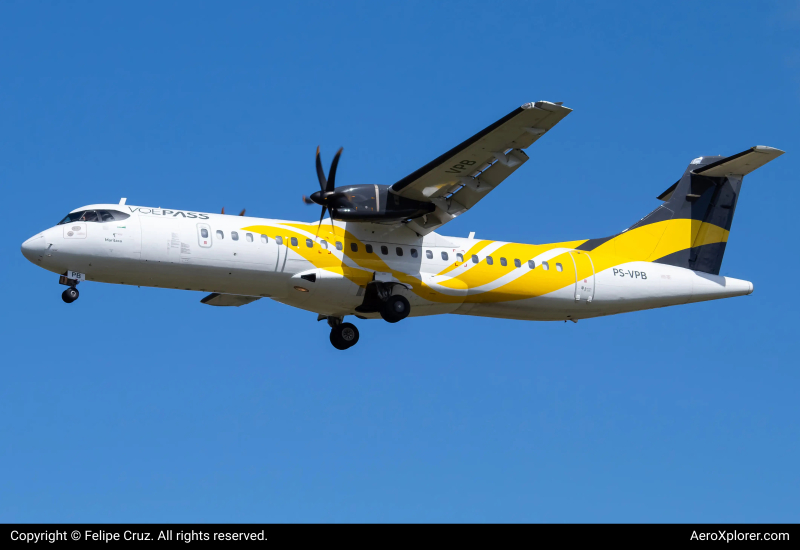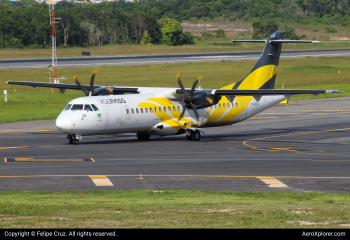A passenger plane has crashed in the São Paulo state of Brazil, killing 62 and destroying homes on the ground.
What We Know
On Friday August 9, Voepass flight PTB 2283 operating between Cascavel Airport (CAC) and São Paulo Guarulhos Intl (GRU) crashed shortly before reaching São Paulo.

The aircraft involved in the crash was PS-VBP, a 14-year-old ATR 72-500 that was flying for Voepass since 2022.
According to a local news agency, GloboNews, the turboprop aircraft was carrying 62 passengers onboard. This figure was later confirmed by Brazilian President Da Silva, clarifying that there were 58 passengers and 4 crew onboard the flight.
Upon hearing of the crash at a naval event in the south of Brazil, President Da Silva asked for a moment of silence for the victims and their families.
The crash site of flight 2283 lies near the city of Vinhedo, just 40 miles (~60 kilometers) from São Paulo airport.
At the time of the incident, weather conditions appeared to be fair, with overcast skies and moderate winds.
Many people have witnessed the aircraft crash, as evidenced by videos posted to social media platforms showing the doomed aircraft spiraling out of the sky.
“There is still no confirmation of how the accident occurred nor the current status of passengers who were onboard” stated Voepass in a statement to the press.
According to speed and altitude data from flight tracking website flightradar24.com, flight 2283 appears to have had a normal takeoff, cruise, and climb out of Cascavel Airport. While the altitude data for flight 2283 doesn’t show any anomalies, the speed data does. If the speed data that flightradar24 provides is accurate when compared to other ATR 72 aircraft that operated flight 2283, the speed of the ATR-72 involved in the crash - PS-VBP - varied wildly throughout the flight. Even at cruising altitude, the ATR 72 involved in the crash had a speed that fluctuated wildly between just 140 knots (stall speed for most airliners), and over 300 knots. This is very uncommon for any airliner and could indicate that the pilots of flight 2283 were having problems with their planes' engines or pitch controls.
This hypothesis is backed up by a video posted to Twitter (formerly X) showing the aircraft in the moments before it crashed. The video appears to show flight 2283 in a spiral dive, almost falling vertically out of the sky. This type of dive is characteristic of an aircraft that has stalled.
A stall occurs when there is not enough air flowing over the wings of an aircraft for the aircraft to stay in the air (maintain lift), so the aircraft begins to essentially fall out of the sky until enough airflow is re-established over the wings for the aircraft to fly safely again.
Usually, pilots are taught how to recover their aircrafts when they stall, however there were most likely other factors at stake which caused the aircraft to stall as well.
Keep in mind that this is just speculation and the investigation into the crash of flight 2283 will determine the real cause of the crash.
Bomb Threat Cancels Air New Zealand Flight, Delays Passengers » Could You Survive a Plane Crash? The Unlikely Science of Plane Crash Survival » Thousands of Flights Impacted as Winter Storm Blair Hits U.S. »
Comments (2)


Add Your Comment
SHARE
TAGS
NEWS BrazilPlane CrashATRPropeller Planes Bad WeatherRECENTLY PUBLISHED
 Could You Survive a Plane Crash? The Unlikely Science of Plane Crash Survival
With air travel consistently being heralded as the safest form of public transport, most of us do not board a plane pondering our chances of survival in the event of a crash. But, is it possible to survive one?
INFORMATIONAL
READ MORE »
Could You Survive a Plane Crash? The Unlikely Science of Plane Crash Survival
With air travel consistently being heralded as the safest form of public transport, most of us do not board a plane pondering our chances of survival in the event of a crash. But, is it possible to survive one?
INFORMATIONAL
READ MORE »
 Maldivian Airlines Introduces First-Ever Widebody Aircraft, Plans New China Flights
Maldivian, the government-owned national airline of the Maldives, has just welcomed its first-ever wide body aircraft: the Airbus A330-200. With the new aircraft, the carrier also plans brand-new long haul international flights to China.
NEWS
READ MORE »
Maldivian Airlines Introduces First-Ever Widebody Aircraft, Plans New China Flights
Maldivian, the government-owned national airline of the Maldives, has just welcomed its first-ever wide body aircraft: the Airbus A330-200. With the new aircraft, the carrier also plans brand-new long haul international flights to China.
NEWS
READ MORE »
 Thousands of Flights Impacted as Winter Storm Blair Hits U.S.
Winter Storm Blair has unleashed a huge blast of snow, ice, and freezing temperatures across the Central and Eastern United States.
As of Sunday afternoon, over 6,700 flights and counting have been disrupted. This includes cancelations and significant delays leaving passengers scrambling to change flights and adjust travel plans.
NEWS
READ MORE »
Thousands of Flights Impacted as Winter Storm Blair Hits U.S.
Winter Storm Blair has unleashed a huge blast of snow, ice, and freezing temperatures across the Central and Eastern United States.
As of Sunday afternoon, over 6,700 flights and counting have been disrupted. This includes cancelations and significant delays leaving passengers scrambling to change flights and adjust travel plans.
NEWS
READ MORE »





